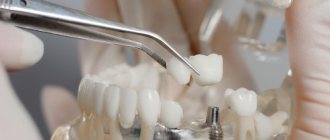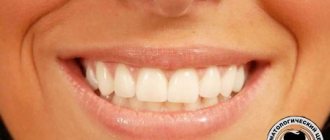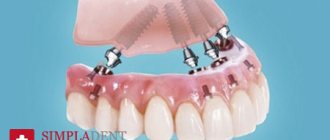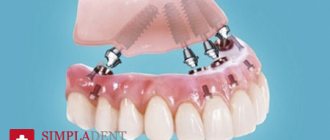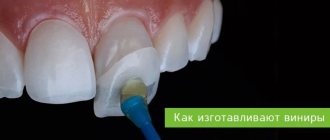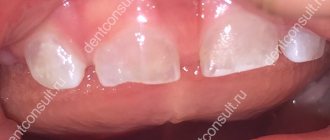Sooner or later, almost all people face the need to have dental prosthetics. Of course, it would be better if such a moment came as late as possible, but if problems with the dentition have arisen, they need to be resolved quickly so as not to cause irreparable harm to one’s own health. What dentures are best to put in if it’s time to “surrender” to the hands of an orthopedic dentist? To make a good choice, you need to know what dentures are in general and in what cases they are usually used.
Review of modern technologies that allow you to insert teeth
Just 30 years ago, there was only one way to replace lost teeth—prosthetics, and patients were offered crowns made of heavy and unesthetic materials—various metal alloys. And no one was embarrassed by the sight of metal teeth in the smile area. Nowadays, you can insert teeth in such a way that no stranger will even guess that you have a crown or prosthesis in your mouth, and not your natural teeth - to do this, just choose crowns made of metal-ceramics, ceramics or zirconium dioxide.
Teeth can be replaced using dentures or implantation. Both technologies are universal and applicable both for single restorations (in the absence of 1-4 teeth) and for completely toothless jaws.
It is important to understand that implantation does not exclude the stage of prosthetics, however, the crown in this case is not placed on the supporting tooth, but on the abutment of the implant implanted into the jaw bone.
How can you insert teeth in your case? The answer to this question will depend on how many teeth you are missing:
1. If you have teeth, but are severely damaged, you may be offered prosthetic crowns or immediate implantation.
2. If only one tooth is missing in a row, it can be inserted either by installing a denture (bridge) or by implantation. The latter method will be preferable, as it will allow the tooth to be inserted without affecting healthy teeth. The implanted implant will serve as a support for the crown.
3. If a large number of teeth, or even all teeth, are missing in the rows, they can be inserted using removable dentures or dentures on implants.
IMPORTANT: On the Internet you can find many reviews from people who decided to have teeth inserted and subsequently encountered various complications - from pain to prosthesis breakage or implant rejection. There is only one reason for such reviews - poor quality treatment. Therefore, if you decide to have teeth inserted, do not be lazy to spend time carefully choosing the clinic where you will have your teeth inserted.
Both during prosthetics and implantation, you may be offered to insert teeth with different types of dentures and crowns. Let's look at the features, pros and cons of all possible options.
Which is the best method to choose?
There is an alternative to dental prosthetics using implants, and for those who, due to contraindications or other reasons, cannot undergo implantation, this is a real salvation. And in each individual case, a method is selected based on specific conditions, the nature of the clinical picture, the requirements and capabilities of the patient.
But still, when choosing, it is necessary to take into account that implantation today is essentially the only method that provides complete restoration of the functionality of the dental system, including stopping bone atrophy. Perhaps a full-fledged alternative to dental implantation will appear in the near future, but for now it does not exist - all methods of prosthetics without implantation have disadvantages and do not ensure the transfer of chewing load to the bone, which causes degradation of the jawbone, gradual displacement and destruction of the remaining teeth.
Insert teeth with metal-ceramic crowns
You can inexpensively replace teeth with metal-ceramic crowns. Such dental prostheses have a metal base and are covered with a layer of ceramic mass on top. This is done so that the finished crown has a natural and aesthetic appearance.
Metal-ceramic crowns are used in both traditional prosthetics and implantation, however, if you need to insert a front tooth, this option of dentures is not suitable. The fact is that the metal from which the base of the crown is made oxidizes over time and this reaction can cause the gums to appear blue in the area where the crown is installed. This cyanosis will be clearly visible when smiling or talking, which of course will affect the level of aesthetics.
If you want to see what a smile will look like if you replace your teeth with metal-ceramic crowns, look at the photos we publish below.
Features of removable dentures
Removable dentures are those that can be removed and installed independently without the help of a specialist. The main indication for their installation is the impossibility of implantation or restoration of dental units with bridges.
The type of construction is chosen based on the number of missing teeth, their location in a row and other factors. There is no best removable denture that would be suitable in all cases; everything is strictly individual.
Insert ceramic teeth
Inserting ceramic teeth will be the right decision if you need to restore your front teeth, which are clearly visible when communicating with people around you. But for the restoration of chewing teeth, ceramic crowns are not suitable: ceramics is a fairly fragile material and a crown made from it may not withstand the heavy load that is constantly placed on the chewing teeth when chewing food.
The high aesthetics of ceramic crowns determines the expensive prices for this type of orthopedic structures. But the patient gets a beautiful and natural smile: you can also evaluate the results of dental restoration with ceramic crowns from the photos that we have posted below. Ceramic crowns can be placed on both the abutment tooth and the implant.
Veneers and Lumineers
Veneers and lumineers can be used as aesthetic options for dentures on the front teeth. Veneers are very thin shells of porcelain that are given a color similar to the natural color of the patient's teeth. Veneers completely match the shape of a natural tooth. Such plates are attached to the front surface of the tooth.
Lumineers are transparent and very thin plates about 0.15 mm thick. Placed on the front surface of the tooth. This cosmetic procedure is non-invasive, quick, painless and long lasting.
These qualities determine the indications for the installation of veneers or lumineers:
- Crack and small chip of a tooth;
- Yellowing or darkening of tooth enamel;
- Uneven frontal surface;
- Crooked teeth.
How to insert a tooth if there is no root?
If you have had a tooth removed, you can insert it using implantation, and this can be done immediately after the extraction procedure - using the method of one-step implantation. With this method of tooth restoration, implants are implanted directly into the socket of the extracted tooth and then a temporary prosthesis is placed on them. Simultaneous implantation will allow you to insert a tooth and not walk with an unpleasant dentition defect. The doctor will install a permanent crown on the implant abutment after it has fused with the bone - this usually takes 3-4 months.
Implantation is recognized as the most reliable and durable way to restore extracted and lost teeth, but it is not always possible to replace teeth with it - there is a fairly wide range of contraindications for this surgical operation.
Nylon prosthetic structures
An alternative to plastic are systems made of nylon: soft, flexible, elastic, do not rub or injure the gums.
This is an excellent option for partial dentures and the best removable dentures used when several teeth are lost in a row or in different areas of the jaw.
They are attached to the supporting teeth with nylon clasps and are almost invisible. They completely imitate natural fabrics and do not cause psychological discomfort.
In cases of complete edentia, they are not used because they cannot provide reliable fixation. In addition, nylon is a soft elastic material; under increased chewing loads it deforms. For completely edentulous patients, acrylic suction cup systems are preferable.
How are dental implants inserted?
Implantation, in order to insert teeth, can be carried out in different ways: according to a one-stage or two-stage protocol. But its essence will always boil down to the following: in order to insert a lost tooth, the doctor will implant a special structure in the patient’s jaw - an implant, on which he will subsequently install a crown or prosthesis.
Until the stage of permanent prosthetics, you will walk with a temporary prosthesis, which is placed during one-stage implantation immediately after implantation. In two-stage implantation, immediate dentures are used to mask dentition defects.
A permanent crown or prosthesis is placed on the implant only after it has completely fused with the natural bone tissue of the jaw. Crowns for installation on an implant can be made from any material: for the restoration of front teeth, ceramic crowns are most often used, for the restoration of chewing units - products made of zirconium and metal-ceramics.
Which implantation technology should I choose to insert teeth? It is impossible to give any absentee recommendations on this matter. You need to visit the clinic, undergo an examination and diagnosis, and only after that the implantologist will offer you the optimal implantation method.
Implantation
Implantation is the most modern method of restoring dentition, which is the implantation of a rod into the bone tissue, onto which a removable or fixed structure is attached. With all the advantages (reliable fixation, restoration of dentition of any length, aesthetics, long service life), implantation also has disadvantages:
- high price;
- high level of trauma and pain;
- likelihood of rejection;
- the likelihood of complications from the nervous system;
- a large list of contraindications.
You can find even more about the features of restoring lost teeth through removable and fixed prosthetics, and how much it costs to install an implant in the materials on our website.
The Meliora Dent clinic offers a full range of dental services, including all types of prosthetics and implantation.
If you need to insert a tooth after it has been removed
The best solution to insert one tooth is a one-time implantation, but a tooth can only be inserted if too much time has not passed since its removal. To firmly fix the implant in the bone, the jaw bone tissue must be dense and have a certain height. But the longer a tooth is missing, the more the bone thins and dries out. Therefore, if you had a tooth removed several years ago, you can have it replaced either with prosthetics or classical implantation.
When are alternative methods required?
There are absolute and relative contraindications for implantation. Absolute ones are those that make implantation impossible in principle. These include:
- various pathologies of bone tissue,
- diseases of the immune system (HIV, AIDS, etc.),
- autoimmune diseases,
- oncology,
- severe infectious diseases (tuberculosis),
- nervous and mental diseases,
- blood diseases (especially bleeding disorders),
- children's age (up to 18 years).
Relative contraindications include problems that are temporary or can be corrected and, after restoration of health, allow implantation. These are states such as:
- pregnancy and lactation,
- rehabilitation period after heart attack and stroke,
- acute viral diseases,
- dental diseases (caries, pulpitis, periodontitis, stomatitis, etc.),
- exacerbation of chronic diseases,
- dysfunction of the mandibular temporal joint,
- severe atrophy of the jaw bone,
- malocclusion,
- alcoholism and drug addiction,
- poor oral hygiene.
If you are unlucky and you are one of those who are contraindicated for dental implants (at least in the next few years), then you have to look for alternative methods.
How much does it cost to get teeth inserted?
Teeth can be inserted in different ways and using different crowns or dentures, so the price of the service can be very different. Below we publish prices for services for restoring damaged or lost teeth, which are offered by our dental clinic in Moscow - “Aesthetica”!
If you want to insert teeth so that the restoration result is both beautiful and high-quality, come to our dentistry! We have created all the conditions for high-quality, painless dental restoration in the most difficult cases!
Acry-free removable prosthetics systems
When analyzing which removable dentures are better, one cannot help but consider the “Acry-free” designs based on improved acrylic plastic.
The material does not contain methyl methacrylate, therefore it is more flexible and soft than acrylic. Dentures are comfortable to wear and are used in cases of complete or partial absence of teeth.
Experts and patients note the high aesthetics of Acri-free systems - they perfectly imitate natural teeth and gums.
They are fastened with clasps made of translucent material, are invisible and do not cause inconvenience.
The main disadvantage is the high price.
